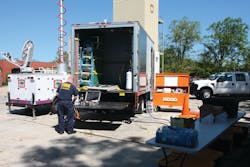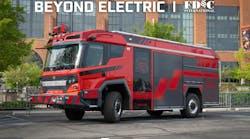There is an old saying that goes, “There is going to be weather, whether or not.” While this is certainly true, it seems that during the past 12 months, much of this weather has been extreme.
Record temperatures, heavy snows, tornadoes, hurricanes, tropical storms, high winds and heavy rains have all made the headlines. More than this, a significant number of these weather events have severely taxed the fire-rescue service. Add in other natural phenomenon like earthquakes and tsunamis and you have what amounts to a perfect storm of demands being placed on our resources.
One resource that can easily feel the strain is your communications network. That’s why it’s critical to design, test, staff and adequately finance this function with the worst-case scenario in mind.
Natural disasters place an inordinate strain on communications in comparison to other events. Rather than being isolated incidents, these are region wide – affecting thousands of people. These people are going to be calling for help, tying up your 911 center and calling each other tying up commercial telephone resources. These people include your suppression personnel and your telecommunicators, making it likely that at least some of your staff will be faced with damage to their personal property, childcare concerns and transportation issues.
Natural disasters are not over in a single shift. They come and stay, often for a long time. They present challenges of both volume and duration, and your planning must include this fact. Disasters also break things, and many of these things are critical to operations.
Planning for the Worst
So, where does planning begin? With your disaster plans! Pick them up, dust them off and make sure that everything is right. Is all the terminology correct? Are all the communications resources up to date? Are the names and telephone numbers included in your notifications correct? Does each listing have an alternate means of contact in case the first one doesn’t work?
Conduct a disaster-plan review with an eye on the real world. What is the minimal amount of staffing on duty at any time in your communications center? What duties will they be expected to perform in addition to processing the increased amount of emergency calls that can be expected during a crisis? How long will it take them to execute disaster notifications and related functions? Is this time line acceptable? If not, what are alternatives that allow the shedding of work load or assigning these processes elsewhere?
I am unfortunately aware of numerous Public Safety Answering Points (PSAPs) that are tasked with expectations that far exceed their capacity to perform even on a quiet day. For example, do we honestly believe that a single person on duty will be able to function as both the local dispatcher and regional control during a major fire, let alone a hurricane? The odds of a successful outcome are slim. Inadequately staffed resources – whether they are ladder companies or dispatch centers – cannot perform past a certain level. That’s why it’s important to test your communications disaster plan by working through it. We drill for a reason. And, it’s also critical to establish timelines for update and review. Since many documents are now stored electronically, it’s extremely helpful to create a means of automatically updating your plan when changes are made in supporting documentation.
While scheduled periodic reviews are important, it’s even more important that critical changes be made in real time. For example, if the chief gets a new phone number, it needs to be entered immediately, and not discovered as part of a 90- or 180-day review or, worse yet, during an actual incident. It’s also important that electronic files are accessible to all who need them when they need them and properly backed up on independent devices. This means on two separate servers or PCs that do not sit next to each other and share the same power plug. Laptops are a great way of providing certain types of backup since they are mobile and provide flexibility. Even so-called “thumb drives” can hold quite a bit of information stored in widely recognized formats such as PDF or Word.
Security & Stability
Obviously, the security and stability of your dispatch center is of prime importance to maintaining communications. Since the loss of electrical power is often one of the side effects of disasters, due care must be taken in assuring viable and adequate sources of energy. Again, focusing on the concept of no single point of failure, this often involves the use of generators and Uninterruptable Power Supplies (UPS). However, these do not operate without proper maintenance, and both should be exercised regularly under load. National Fire Protection Association (NFPA) 1221, Standard for the Installation, Maintenance and Use of Emergency Services Communications Systems, 2010 edition, calls for generators to have at least 24 hours of fuel. Industry rule of thumb often uses 72 hours as a safe buffer. However, Hurricanes Katrina, Wilma and more recently Irene have cast doubt upon this wisdom by creating much lengthier scenarios. Part of your planning, therefore, should take into account having contracts and agreements in place to secure the additional fuel, services and supplies needed to assure protracted operation.
Additionally, planning should account for the potential of community isolation. From the Outer Banks of North Carolina to small towns in Vermont, communities were literally cut off from conventional means of outside access for a number of days. Will a contract for diesel with a supplier 25 miles away be of any value if the only bridge to town is out?
PSAP Readiness
Continuing your PSAP readiness inspection, a check of your UPS system is in order. Are all the batteries fresh? Has it been tested lately? Have devices been added to the load that diminish its run time? It’s not unheard of for equipment to be continually installed in the PSAP without regard to expanding the battery racks, thereby reducing what was once a comfortable one-hour buffer to an uncomfortable 15 minutes or less.
Check on the status of all circuits. Everything that is on generator does not have to be on UPS. Some circuits may not need emergency power at all. But make doubly sure that those devices that you will rely upon during a disaster are operational, and visibly designate the difference between emergency and normal outlets.
There are any number of horror stories that come from failures in this area. In one facility I inherited, an exterior junction box had been installed so that power could be supplied by a remote source if the backup generator failed. This was a great idea, except that the circuits it was wired to didn’t include any critical equipment. The coffee pot and microwave would have worked; the consoles and transmitters would have not.
In more than one case of which I am aware, fuel pumps of generators were connected to the commercial grid, rather than to the emergency side of the circuits. The result? Once the day tanks ran dry, the facilities went dark, even though there were thousands of gallons of fuel on hand underground. There are also cases where a critical device was switched from one wall plug to another during routine maintenance. This doesn’t sound like a problem, until you realize that the second plug wasn’t on generator power. It doesn’t take much imagination to guess when this was discovered. When it comes to indispensable devices, no maintenance is “routine.”
Transfer switches are also an important part of emergency power supplies, and it’s important to know the means for manually engaging them when they fail. The same is true of UPS bypass switches. Someone on duty should always have access to these controls and be well versed in their operation.
Remote Sites
Readiness planning should also extend to remote sites. Reliable power and accessibility are among the many concerns. Since some may be in normally hard-to-reach locations, additional assistance may be needed to ensure access during disasters. The ability to monitor these sites also comes into play. One communications center had its transmitter stolen from a mountaintop enclosure. Since there was no intrusion detection, they learned of the theft only after units stopped acknowledging their transmissions. While some of the stories may seem fanciful, I assure you that they are all real and not so humorous to the people involved. Carrying fuel cans uphill during a blizzard to fill an auxiliary diesel tank is not much fun.
In the same light, those of us in public safety have real-world knowledge of Murphy’s Law. However, when it comes right down to it, Murphy was an optimist. Failure to anticipate – and address – multiple communications failures has been the undoing of many a plan. For example, there are a variety of outages that can impact our telephones. These range from the loss of one or more 911 trunks, neighborhood failures and end-office isolations wherein customers cannot dial out of a region, to the loss of the central office that supplies 911 service itself. While the latter is a low-probability/high-impact event, it still must be considered.
Some plans calls for the use of public works vehicles to drive through neighborhoods to serve as emergency contact points or the directing of the public to report to their closest fire station to sound the alarm. But during a disaster, will these vehicles be available? Will anyone be left at the station during a response? If not, what then?
Telephone Failures
Planning also needs to consider the impact of telephone failures on other aspects of communications. How many alarm circuits depend on the local telephone office? Nor are wireless or Voice over Internet Protocol (VoIP) technologies immune from impact. How many remote radio sites are controlled or monitored by means of dedicated circuits? How many applications such as Automatic Vehicle Location (AVL) or Mobile Data Terminals (MTDs) rely on “air cards” and commercial cellular service to operate? What would happen if you lost any of these functions? Some of them? All of them? While carriers tend to be extremely reliable, there are some important facts to remember.
In the wake of Hurricane/Tropical Storm Irene, the Federal Communications Commission (FCC) reported that 6,500 cell sites were down, including 44% of cell sites in Vermont. And despite the presence of significant infrastructure redundancy, telephone systems in parts of Louisiana were overwhelmed by the sheer magnitude of Hurricane Katrina. So, plan for the worst and expect the worst. Part of this planning should include the registration of all of your critical telephone lines for priority restoration, and additionally registering those selected for priority service access through the Government Emergency Telecommunications Service (GETS) www.ncs.gov. Dialogs should be opened with your conventional, VoIP and wireless providers in order to better understand your local vulnerabilities and options. Access to units known as Cell On WheelS (COWS) can help to restore service, but it is important to understand their availability and limitations prior to an actual event.
Needless to say, if your infrastructure is failing because of weather conditions, your dispatch center may also be at risk. I have seen many facilities surrounded by sandbags year-round because of their close proximity to major rivers like the Mississippi. I have also seen others quickly inundated when a normally docile local creek overflowed its banks. A measurable number of 911 centers remain underground, making them extremely susceptible to flooding.
The decision of how, when and where to evacuate must be codified well in advance of the event in order to achieve continuity of operations. Moving just a block or two will probably not cut it, as conditions mandating the evacuation will likely affect a sizeable area. Appropriate attention is usually paid to the transfer of 911 calls, but this still doesn’t solve a bigger problem; how to get them dispatched. If your PSAP operations are relocated to an adjoining county or state, how will the appropriate emergency information be relayed back to first responders? Are regional radio networks, common frequencies, data nets, or mutual aid channels in place? If not, what’s your plan?
Radio Communications
This leads us to another critical link in the natural disaster plan – radio communications. We have already discussed the need for appropriate power at the dispatch center and remote sites, but the need for power also continues to portable radios, pagers, personal digital assistants, netbooks and laptops. As our reliance on these devices increases, so does our need to ensure their uninterrupted operation during protracted events. So-called quick chargers for our portables are good, but this still means that a sufficient number of batteries must be on hand and charged prior to the emergency so that immediate swap outs can occur. These chargers must also be located at facilities having emergency power.
One of the most flexible and beneficial tools for smaller electronics is the mobile charger. You don’t need a backup generator; a car battery will make it work. This is good advice for the public as well. As more and more citizens get their news and emergency notifications via web-enabled devices, this gateway quickly closes when the batteries go dead. Another overlooked need can be the parts and labor required to accomplish radio repairs. While redundancies, excess capacity and spare radios can carry you through an initial crisis, equipment failures can eliminate all of these positives. Having trained and well-supplied technicians available provides an additional layer of protection.
Interoperability Issues
Interoperability, of course, must be considered; especially where resources from remote areas are called in to assist. In true disasters, assistance may be provided by federal and state agencies as well as the private sector. The most important decisions are the level of interoperability required and how this interoperability will be accomplished. For local responders, this interoperability may already built in. For others, fixed or mobile patches and pools of portable radios can usually handle the task. Since it is not necessary (and probably not a good idea) for everyone to be able to talk to everyone else, some interoperability may be carried out face to face or by telephone from the command post or emergency operations center.
Some final thoughts to consider concerning radios are that even multi-frequency trunking systems can get overwhelmed, and that inclement weather can have an impact, as well. The first lesson I learned firsthand, when my center handled a significant tornadic event, was that very early in the response it became clear that our normal practice of assigning a talk group to every event was not going to work. There were just too many calls. In the second case, as a general rule of thumb, wind, rain, ice and snow can lessen the coverage and clarity of certain radios. Take this into account when operating in known areas of marginal performance.
Finally, to make this all work, you need to ensure the safety and presence of your communications staff. They will be expected to work long hours, field more and unfamiliar types of calls and will be dealing with issues of loss of utilities at their homes; perhaps even loss of those homes themselves. They will have dependent minor and elder-care issues, yet will need to function at high levels of productivity for days on end. They may require access to transportation and non-traditional forms of day care.
Since relationships between telecommunicators and first responders are not uncommon, their significant others may have also been recalled to duty. Work out these issues as thoroughly as possible long before an event. Once they get to work, they will have to be fed, boarded and provided sanitation. Is there space onsite for sleeping? Are hotels or shelters nearby? What plans do you have for drinking water or bathing if the water plant goes off line? And where do you get a half-dozen portable toilets after the sewer plant is flooded?
In order to assist in protracted events, a number of states have instituted Telecommunicator Emergency Response Taskforces (TERTs) designed to formally augment local staffing. More information on these programs can be found at http://www.njti-tert.org. Again, preparing for the worst makes everything else look easier.
While some of the concerns mentioned here may have been mentioned before, the need for critical planning deserves repeating. Since there are no reports of public safety communications systems failing during the recent East Coast earthquake, you may never have to experience these problems firsthand. Demands can come from anywhere and at any time. With a little luck – and a lot of planning – you can successfully weather any storm.






